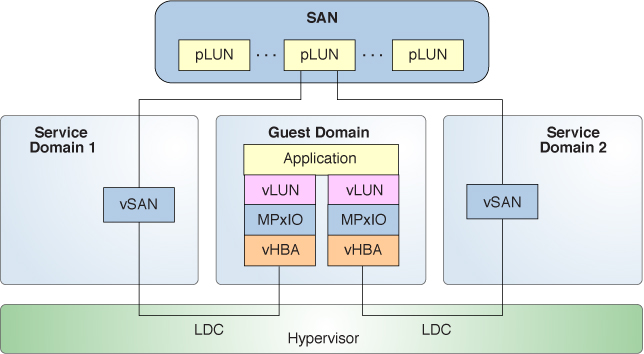Configuring Virtual SCSI HBA Multipathing
The virtual SCSI HBA subsystem supports multipathing in the guest domain by leveraging the native Oracle Solaris multipathing implementation (MPxIO). For more information, see Managing SAN Devices and Multipathing in Oracle Solaris 11.3 .
As in native multipathing, a specific back-end SCSI device can be accessed by one or more paths. For the virtual SCSI HBA subsystem, each path is associated with one virtual LUN. The scsi_vhci module implements the native multipathing behavior, which sends I/O requests to the set of virtual LUNs based on arguments passed to the associated mpathadm administrative command. For more information, see the scsi_vhci(7D) and mpathadm(1M) man pages.
To configure multipathing, you must configure two or more distinct paths from the guest domain to the same back-end device. Note that multipathing still operates with one configured path. However, the expected configuration has two or more paths that send their I/O requests through distinct physical SCSI HBA initiator ports that reside on distinct service domains.
Execute a pair of ldm add-vhba and ldm add-vsan commands for each separate path to the back-end storage.
Enable native multipathing in the guest domain for the initiator ports that are managed by the vhba virtual HBA module.
Note - The virtual SCSI HBA subsystem does not support the enabling of native multipathing in the service domain. If you expect to see LUNs and they are not shown in the ldm list-hba output for a specific service domain, verify that MPxIO is disabled for the LUNs' associated physical SCSI HBA initiator port. If necessary, use the stmsboot command to disable MPxIO for the initiator port.
The following figure is an example of a multipathing configuration. It shows one physical LUN of a SAN that is accessed by two paths that are managed by MPxIO. For a procedure that describes how to create the configuration shown in this figure, see How to Configure Virtual SCSI HBA Multipathing.
Figure 9 Configuring Virtual SCSI HBA Multipathing
